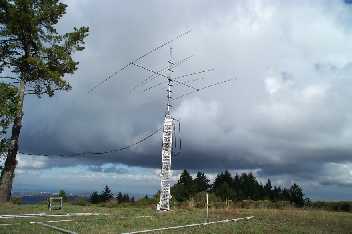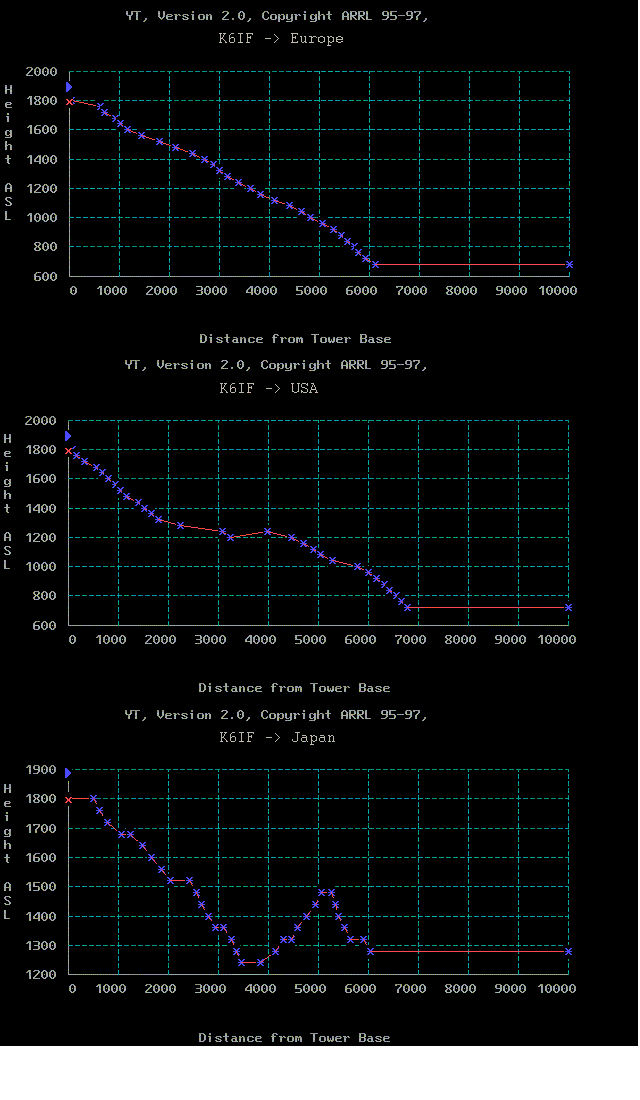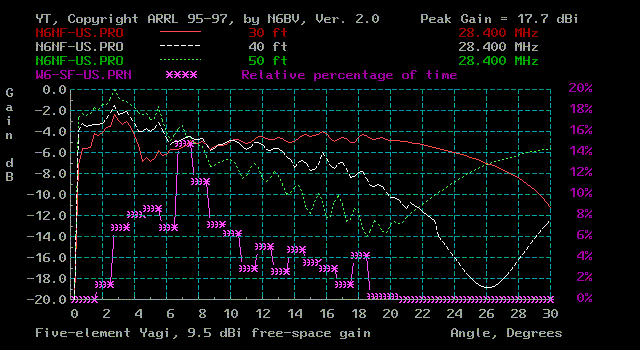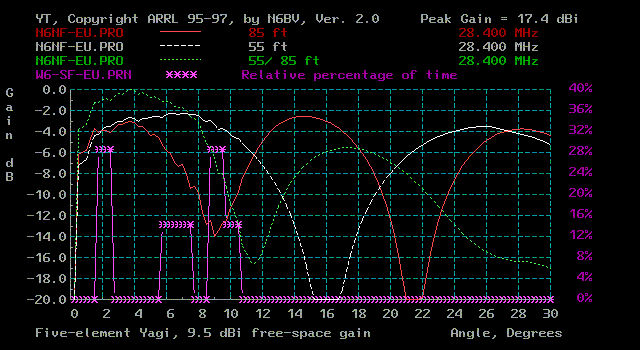K6IF's Quest - The 2000 ARRL 10 Meter Contest
Part 2: Plan B - A whole new station in 60 days
Ok, great. So now I have a world class QTH to operate from.
Only a few minor problems.
1) No antennas. Tom's tower is almost bare already, and the old
Telrex tri-bander is coming down at the end of November.
2) No computer controlled radio. Tom has an old TS-940, which
is a great rig, but not one that I am familiar with. It also lacks
computer control, which I have become addicted to.
But - one of the fun parts on contesting for me is planning and preparing
for the contest. So I viewed these annoyances as just that, and began
to plan.
 My
first major constraint is the mechanics of Tom's tower. His tower
is a heavy duty 70' crank-up, with an 18' tall 3" heavy duty mast.
The only good places to mount antennas on crank-up towers are on the mast,
and at the top of each section of tower. Tom's tower is a four section
tower, so the section tops are at about 23', 39', 54' and 70'. Allowing
for a couple of feet of mounting bracket, that meant that I could mount
antennas at 25', 42', 56' and 70' or higher.
My
first major constraint is the mechanics of Tom's tower. His tower
is a heavy duty 70' crank-up, with an 18' tall 3" heavy duty mast.
The only good places to mount antennas on crank-up towers are on the mast,
and at the top of each section of tower. Tom's tower is a four section
tower, so the section tops are at about 23', 39', 54' and 70'. Allowing
for a couple of feet of mounting bracket, that meant that I could mount
antennas at 25', 42', 56' and 70' or higher.
The next thing that I did was to grab a copy of the new ARRL
Antenna Book, and install the latest version of YT on my computer.
YT is a terrain analysis program that runs on PC's, developed by Dean Straw,
N6BV. I knew that Tom's QTH had steeply sloping foreground in many
directions, and I knew that the foreground would matter in designing an
antenna system for the contest. What I didn't know, until I modeled
it, was what that effect would be :-)
I used Microsoft's Terraserver
database to find the appropriate topographical map, which I then used
to create the terrain profiles for YT to use.
For your interest and entertainment, here are the plots of the terrain
at Tom's place to EU, US, and JA:

I ran a ton of models on YT, and spent a bunch of time thinking about
antenna configurations. I run a C-3E stacked with a home-brew 3 element
10 monobander at home, so I know that having the ability to beam in two
directions can be a big win. I routinely beam to Europe and the US
or Japan and the US at the same time, using an Array Solutions Stack Match
as a splitter/switch. This works so well that I was sure I wanted
similar capability for this contest. That meant at least two antennas.
Once I decided that, I kept my eyes on the swap pages. I found a
brand new StackMatch that had never been installed for $225 on eham.net.
I bought it, put it in a box, and continued my planning.
As I thought about it and played with YT, it became clear that I was
going to need a low antenna for the US. On a mountain top, antennas
above about 40 feet or so have good low angle radiation, but their second
lobe leaves a big hole above about 8 degrees - critical for stateside work
on 10 meters. You can see this effect clearly in this plot that compares
antennas at 30, 40 and 50 feet from Tom's place to the US. The 50
foot antenna is down 6 db compared to the 30 foot antenna at 15 degrees
elevation angle.

But especially for Europe and Japan, I wanted an antenna as high as
I could get it. After all, height matters for optimal low angle radiation.
Since long distance QSO's on 10 rely on low angles of radiation, I wanted
an antenna at the top of the tower. At least that is what I thought...
Then I actually ran the model on YT, and look at what I found:

If you compare the yellow and red lines, you can see that the 55' antenna
is basically the same as the 85 foot antenna at 2 degrees, and has a much
broader first lobe. At 9 degrees, where N6BV believes there is a
spike in arriving signals from EU, the 55 foot antenna is 10 db better
than the higher antenna. This amazed me, but unless YT is just wrong,
I would be better off with an antenna at 55' than at the top of the tower.
But there are other reasons to want a high antenna. If you look
at the green line on the plot above, you can see that a stack at 55' and
85' is 3 db better than the 55' by itself at 2 degrees.
So I put this all together, and decided that if I could swing it, the
optimal plan was a three stack at 25', 55' and 85'. The 25' antenna
would be mounted at the top of the first section of the crank-up, and fixed
to the US. It would be my go-to antenna for stateside, with a nice
broad lobe with good gain at all the typical US angles of arrival.
Unless I wanted to hear DX really well or the band is dead to the US, this
antenna will always be active. The 55 footer will be my main antenna
for EU and JA, covering the 0-10 degree range nicely. During
the day, I will stack the middle antenna with the low one for better gain
to the US. Early in the morning and late at night, I will add the top antenna
for that extra punch at very low angles to EU and JA. The two stack
of the middle and top antennas will probably open and close the band for
me. Also, having three antennas will let me stack the bottom two
for the US during the day, and using the top antenna for South America,
Africa, etc.
Now that I knew how many I wanted to build, all I needed was a plan
to build it! That takes us to our next segment...
Part 3: You want a three stack of what?

 My
first major constraint is the mechanics of Tom's tower. His tower
is a heavy duty 70' crank-up, with an 18' tall 3" heavy duty mast.
The only good places to mount antennas on crank-up towers are on the mast,
and at the top of each section of tower. Tom's tower is a four section
tower, so the section tops are at about 23', 39', 54' and 70'. Allowing
for a couple of feet of mounting bracket, that meant that I could mount
antennas at 25', 42', 56' and 70' or higher.
My
first major constraint is the mechanics of Tom's tower. His tower
is a heavy duty 70' crank-up, with an 18' tall 3" heavy duty mast.
The only good places to mount antennas on crank-up towers are on the mast,
and at the top of each section of tower. Tom's tower is a four section
tower, so the section tops are at about 23', 39', 54' and 70'. Allowing
for a couple of feet of mounting bracket, that meant that I could mount
antennas at 25', 42', 56' and 70' or higher.


